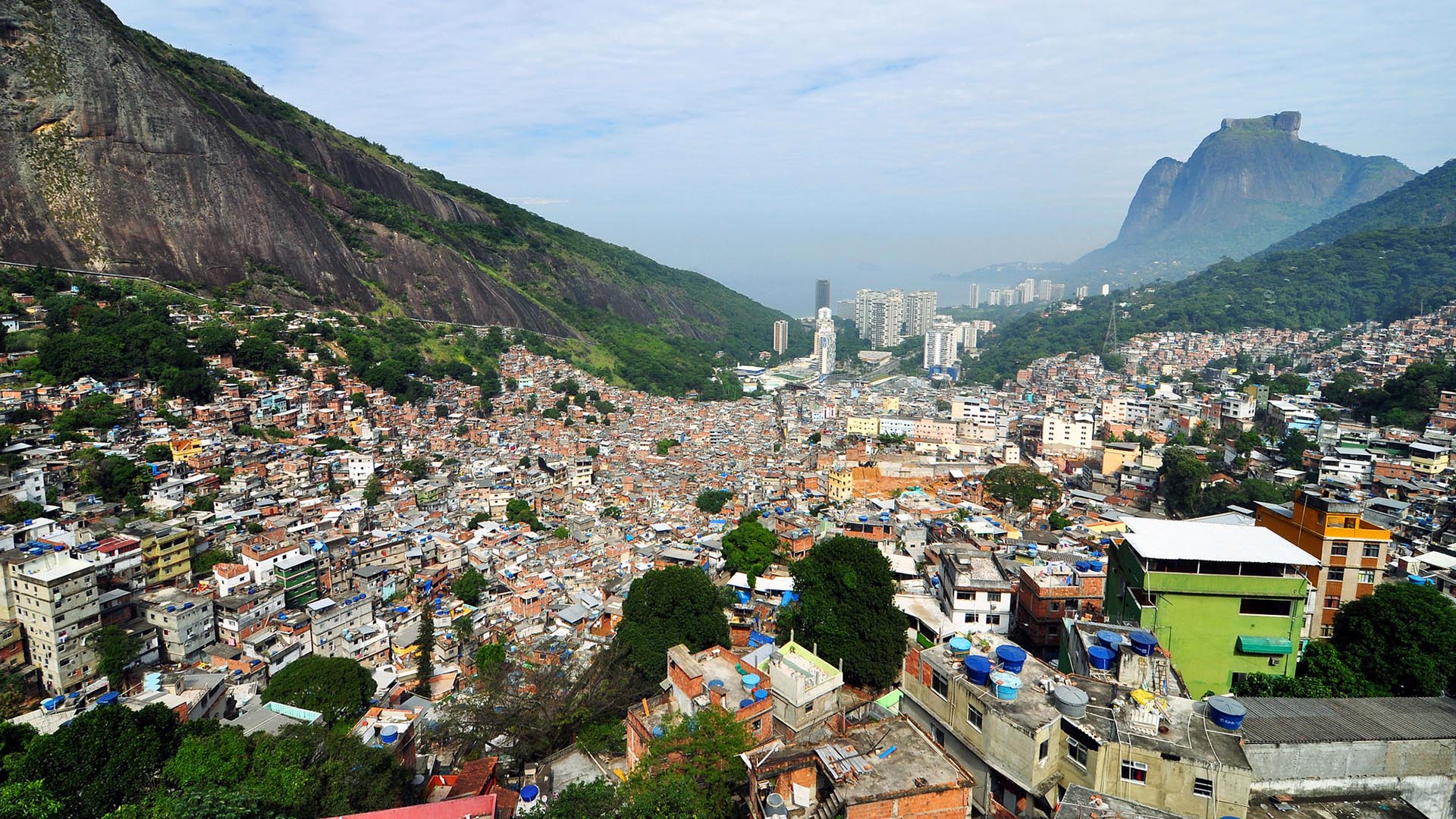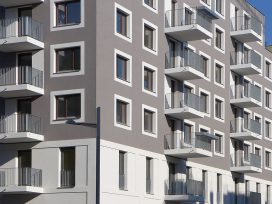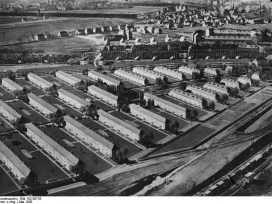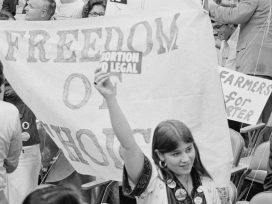While almost all time feels more historically important than it really is, it is undeniable that we are living through a moment of profound epidemiological, social, economic, and political significance. Today’s particular concatenation of economic, public health, and climate crises requires social housing to be at the centre of policy responses.
It is precisely in these moments of crisis where a battle of ideas is most consequential. To illustrate, in Thomas Piketty’s latest doorstopper of a book, Capital and Ideology (2019), he rewrites the history of another moment of apparent importance: the French Revolution. He argues that it was an utter failure, doing almost nothing to change the structure of property ownership in French society. Why? ‘Political time accelerated: although certain ideas were ripe for application, there was no time to put them to the test in concrete experiments,’ he writes. ‘Political actors caught up in fast-moving events often have no choice but to draw on a repertoire of political and economic ideologies elaborated in the past. At times they may be able to invent new tools on the spur of the moment, but to do so takes time and capacity for experimentation that are lacking.’
Only twenty years in, we are now already in the midst of this century’s second housing crisis. The first, in 2008, was rooted in the financing of private home-ownership in the United States and spread through the interlocked global financial system. The second, triggered by the coronavirus pandemic, is rooted in the patterns of unaffordable and therefore overcrowded housing, as well as the lack of basic services like water and sanitation, that characterize our urbanized world. Though it is still unclear how long the public health crisis due this pandemic still has to run, we already know that marginalized housing conditions are both a critical vector for its spread and a critical factor of individual vulnerability.
And we are already living amidst the third crisis of our century: climate change. It moves more slowly, but it holds potential of being much more catastrophic. Like the other major crises of this century, the climate change crisis is also a housing crisis. The human necessity of shelter is the golden thread between our current emergency and the possibility of a just and carbon-free future.
The geography of the current crisis
Crisis exposes the elementary units of social exclusion. The spread of the coronavirus has had a distinct political geography. Earlier this year, the places filled with ‘globalist’ professionals were hit first in country after country. From these localized ‘cores’, the virus has moved on to the social peripheries. In Italy, the spread began in the country’s wealthiest and most globally-connected region of Lombardy and spread outwards. Across the United States cases first surged in wealthy coastal cities like New York and Boston.
Now the places with the highest rate of growth are increasingly poor and rural. Even in richer cities, the poorest neighbourhoods and nearby suburbs bore the brunt of the disease. While density was a commonly cited reason, more careful studies now suggest that overcrowded housing and lack of adequate sanitation better explain this geography.
Just as spread within cities and countries had a distinctly core-periphery trajectory, we see a common path emerging between rich and poor countries. International travellers were the first to contract the disease in the largest cities of two of the world’s most unequal countries: South Africa and Brazil.
In Brazil, political elites were a key vector. A government junket to Donald Trump’s Mar-A-Lago estate on 7 March appears to have been a breeding ground for the disease, after which a number of ministers and aides to Brazilian president Jair Bolsonaro tested positive. A satirical South African video posted on Twitter in March played up the jaundiced view of the inequalities associated with the virus: ‘Corona is for people who have got budget, people who can go to Italy in March.’
These jokes haven’t aged well. The first reports of Brazilian fatalities from the virus were announced on 19 March, with the victims being a doorman and a domestic worker. The latter caught the virus from her employer, who recently returned from Italy.[1]
As the coronavirus spread rapidly from the cores of income, wealth, and political power to the international peripheries of Africa, Latin America, and South Asia, the contemporary global housing divide took centre stage. As Leilani Farha, the former United Nations’ Special Rapporteur on the Right to Housing, said on 18 March, ’Housing has become the front line defence against the coronavirus’.
Government exhortations to self-quarantine and regular handwashing have rung hollow among the estimated one in seven people living in an urban slum. Often they lack access to adequate housing in which to self-quarantine, or reliable water supply. Furthermore, the virus stands to explode the ongoing crisis of structural unemployment and underemployment in the Global South and, increasingly, in the precarious ‘gig economy’ of the Global North.

Cities built on sanitation. Photo via pxhere, CC0 Public Domain.
The history of modern urban governance is, to a significant degree, a history of public health. The widespread distribution of urban public goods like housing, water, and sanitation, by governments has often been in response to the prevalence of communicable diseases. Urban water and sanitation infrastructures have been central to the demographic transition towards higher life expectancy. The role of public housing has likewise often been cast as an intervention in public health. From London in the mid-nineteenth century to Rio de Janeiro in the early twentieth century, urban public goods provision has been a collective action response of public institutions to ease the spread of communicable diseases.
The institutions for recovery
Policies associated with the climate justice framing of the ‘Green New Deal’ in the United States have emphasized the importance of building new social housing and retrofitting existing buildings in order to reduce residential carbon reliance, generate large-scale employment, and guarantee housing for all. The similarly-named ‘Green Deal’ in the European Union has focused more generally on new low-carbon infrastructure projects, though without such an explicit emphasis on the question of distribution and inequality.
The devastation from both the pandemic and from climate change is disproportionately been borne by those on the social and spatial peripheries across the world. Poorer nations are staring down the barrel of a new crisis of sovereign debt ‘unlike anything that we have ever seen.’ This will make it impossible for their governments to guarantee minimum standards of human dignity and livability for years to come, let alone minimize damages from the extreme weather events and slow-bore changes caused by the increase of carbon in the atmosphere.
An estimated 71 million people are expected to be pushed into poverty due to the effects of the pandemic. The peripheral neighbourhoods and regions are used as dumping grounds of toxic waste, air pollution, and located in areas that are likewise vulnerable to the effects of fossil fuels.
One of the most compelling justifications for centring housing in the policy approaches that move away from carbon-based development is that it has the potential to generate widespread political mobilization. And it strikes at the heart of today’s carbon-based development model: globally, buildings account for 40% of energy-related carbon emissions.
Housing movements are social protagonists that are rooted in the places where people live. This produces an expansive outlook on political change, that focuses advocacy on public services, cultural life, and home-based work. Housing movements across the globe are often led by women.
But housing movements also have weaknesses, which suggest that a coalition of housing and labour movements is likely necessary to unlock the mass politics of low-carbon housing. In the United States, this connection between community-based and workplace-based organizing has recently been referred to as ‘bargaining for the common good.’ While the rights of workers and their organizations are codified through the regulatory arm of governments, their demands are generally negotiated with private employers.
Public delivery
The right to housing, in contrast, requires not only public regulation, but also public delivery. For a low-carbon transition, each of these sources of power are necessary — the production of new social housing and retrofitted existing housing will require a massively expanded workforce. While housing movements centre the demand for a social basis for greening building stock, the role of trade unions is critical to ensure that the expanded workforce to do this green building strengthens worker power.
Decarbonization requires a clear vision about the institutions it builds on: the bureaucratic arrangements, agencies, and methods of finance to actually realize this vision. The poorer countries of the world, which bear the brunt of the climate catastrophe, hold useful lessons for the entire globe to realize a low-carbon future through a focus on housing. I want to use the example of Brazil to suggest that a more global outlook for finding solutions to the climate crisis can yield important insights that are otherwise overlooked in favour of a narrow toolkit of historical cases.
Brazil’s history since 1988, when it ratified a new Federal Constitution, and 1989, when it held its first elections with effective universal suffrage, has included persistent institutional innovations in urban housing. Movements in the country’s urban shack settlements, known in Portuguese as favelas, have been critical sources of these institutional innovations. This recent history provides useful lessons for a housing-led green transformation, including its risks.
Putting the social in social housing
Brazil has long been the poster child for housing inequality. As the country industrialized and urbanized in the second half of the twentieth century, its divided cities were characterized by wealthy, dense cores and sprawling shack lands on their peripheries. It is no accident that one of the most influential — and untranslated — works of Brazilian urban sociology, by Lúcio Kowarick, is titled Espoliação Urbana (in English, Urban Plunder; 1979).
This process of urbanization peaked during the authoritarian rule of the country’s military from 1964 to 1985. With its heartland in the industrial suburbs of São Paulo, an independent trade union federation emerged in the late 1970s under the leadership of Luiz Inácio ‘Lula’ da Silva. Lula would later go on to serve two terms as the country’s president from 2003 to 2010.

Paraisópolis is the second-largest favela in São Paulo. Photo by Vilar Rodrigo / CC BY-SA from Wikimedia Commons.
This trade union, the Central Única dos Trabalhadores (CUT, or the Trade Union Workers’ Center), was critical to the formation of the Partido dos Trabalhadores (PT, or Workers’ Party), which united trade unionists, intellectuals, artists, LGBTQ activists, and black activists. A critical part of this broad ‘social movement unionist’ alliance included neighbourhood- and city-wide organisations for housing rights. These groups formed a National Urban Reform Movement in 1987.
Ratified in 1988, the process of negotiating a new federal constitution included citizen assemblies in which civil society heavily influenced the text. As a result, Brazil’s constitution contains extensive rights to urban public goods such as housing, sanitation, and transportation. It also includes an overarching principle that is supposed to enable these rights: the ‘social function of property,’ which relativizes the previously sacrosanct rights of private property owners.
After the country’s first elections with effective universal suffrage in 1989, the PT began governing in key municipalities such as São Paulo and Porto Alegre. Experience in municipal government made it possible to develop policy approaches that fed into the agenda of the national urban reform movement. For example, São Paulo pioneered policies for ‘self-build’ housing projects led by neighbourhood associations, known in Portuguese as mutirão. These projects used public funding for neighbourhood associations to directly manage and build new housing developments.
Porto Alegre became the home of participatory budgeting, which has now spread across the world to over 1500 cities in five continents. Residents from across the city, including and especially in poor, peripheral neighbourhoods could organize to re-orient the city’s budgetary priorities. As a result, the municipality increased investment in housing, sanitation and other basic infrastructure in the city’s peripheries.
Momentum from these achievements in municipal government continued to grow. The group of grassroots activists and intellectuals that had first come together under the banner of National Urban Reform Movement in the 1980s saw an opening. In 2001, the centrist government of Fernando Henrique Cardoso passed a law intended to regulate the constitutional ‘social function of housing’. Amongst other provisions, the City Statute required cities to produce master plans. The requirement to plan was a watershed in a context where a lack of planning provided endless openings for wealthy private actors in real estate development and construction to build outside of an established framework.
Following the passage of the City Statue, São Paulo was the first large city in the country to develop a master plan, which relativized the sanctity of private property in order to put into effect the constitutional principle of a ‘social function of property’. Zones of social interest (known by their Portuguese acronym of ZEIS), allowed the municipality to safeguard parts of the city from private development so that it would be affordable to invest in social housing and infrastructure improvements.
At the same time, the PT won its first national election and Lula entered the presidential palace on January 1, 2003. One of his first acts was to create a new Ministry of Cities, a long-held demand of the National Urban Reform Movement. This new ministry attracted many of the finest intellectuals, activists, and planning practitioners throughout the country. It included three separate sub-ministries — housing, sanitation, and transportation — reflecting the importance that each of these goods held as rights enshrined in the country’s constitution.
Decentralizing from the centre
The ministry oversaw new programs to fund municipalities in the delivery of housing, sewers, and transportation infrastructure
In this sense, the Ministry of Cities represented a critical innovation of institutional design: a newly empowered federal agency with the capacity to decentralize implementation to the municipal level. In cities like São Paulo, this reform was also being replicated: city-wide master planning enabled more responsive neighbourhood-level improvements in housing, often in partnership with grassroots housing cooperatives.
In São Paulo, the largest city in South America, these outcomes were striking. While the proportion of households in the city living in favelas stayed about the same between 1991 and 2011, households in these same favelas with access to a flush toilet almost tripled from 25 to 67 per cent. Furthermore, collective evictions of favelas, which had been commonplace, are now quite rare. The same cannot be said of Rio de Janeiro, in which a much larger proportion of the city’s residents live in favelas (25% compared to 11% in São Paulo in 2011), and collective evictions have increased, especially over the past decade.

The Rocinha favela of Rio de Janeiro. Photo by chensiyuan / CC BY-SA from Wikimedia Commons.
The critical principal of institutional reform — strong central government powers to enable empowered local government action — was coupled with strong external social pressure. In São Paulo, the local government grew more capable to counter the power of private property in order to improve marginalized neighbourhoods, which pushed housing movements to demand more.
Not only have older housing movements that developed in the city’s peripheries in the 1980s continued to persist, but newer squatter movements emerged in the early 2000s to demand the right to live in the centre of the city. Occupations of both abandoned buildings in the city’s core and new land on the peripheries created a contentious atmosphere that allowed the city to experiment with the boundaries of private property within the technical sphere of urban planning. Activist urban planners who had worked in the non-profit sector with housing movements increasingly circulated as staff within the city’s bureaucracy.
On their own, these urban policy reforms in Brazil weren’t able to alter the tide of speculative real estate finance as the country’s economy opened up to global market integration or redressing the deep structural inequalities that have characterized Brazil’s political economy for centuries. In the country’s fractured system of campaign finance, the PT came to increasingly rely on the ties that Lula developed to the historically powerful private construction sector. This led to a series of political compromises by the late 2000s, ultimately triggering an exodus of the more progressive administrators in the Ministry of Cities. Nevertheless, the institutional experiments in urban policy in Brazil during this period hold useful lessons for re-thinking how to make large programmes of new, low-carbon social housing a reality.
In São Paulo, housing movements increasingly focused on dense, inner-city locations that are critical for delivering low-carbon social housing at a meaningful scale. Even so, Brazil’s experiments in urban social housing have not generally been particularly low-carbon. My point here is that the social mobilization behind these experiments illustrates a way for threading the political needle that would allow for a future of low-carbon homes for all.
Lessons from the recent past for the near future
The most common reference points in debates about social housing have a distinctly Western, twentieth-century tinge. On the spectrum of the oft-cited cases, the quintessential positive is ‘Red Vienna’s vast social housing estates built between the two world wars. The British council estates, which were a critical component of the country’s post-WWII welfare state expansion, fell prey to privatization by the Thatcher government. This makes the UK a middling case.
The cautionary tale is in the towering high-rises of the United States’ adventures in public housing in the middle of the 20th century. These became the popular image of concentrated poverty and crime due to disinvestment by federal and local authorities once their occupants were increasingly Black.
The scale, intentions and outcomes of these efforts are surely worth considering, for good and for ill. Daniel Aldana Cohen, in his seminal essay on the connection between a low-carbon transition and social housing policy, drew on these experiences, especially in Vienna, to find two key lessons: sufficient financing is needed to maintain housing over time and subsidize the poorest tenants, and one must build quickly. These historical examples of social mobilization driving institutional support for social housing are critical, as are the lessons that Cohen draws from them.
Clearly, there are ideas available to us from the past to speak to the present. The challenge is not only to identify the relationships of power that link the goal of a sustainable economy to housing justice, but also the institutions through which to channel social pressure.
To be prepared to seize on the ‘repertoire of political and economic ideologies elaborated in the past’, as Piketty puts it in Capital and Ideology, requires a clear institutional imagination to respond to the nature of the crises that we face.
The Brazilian lesson
The Brazilian lesson from the 1990s and 2000s illustrates how social pressure can be combined with the nuts-and-bolts work of building institutions. The more recent failings of Brazil’s democratic experiment can be tied to abandoning the movement-led approach to institution-building that characterized the PT’s successes in the 2000s.
Political scientist André Singer, who once served as a spokesperson for the PT, described this as a transformation towards ‘Lulismo,’ a reliance on a personalistic form of politics that has reached its terrible apotheosis under the current president Jair Bolsonaro.
But the whole world can learn from the two-step that we see in Brazil’s recent experiments in building institutions to deliver social housing. This is not only, or even primarily, because of the sheer numbers of houses delivered, though they are plentiful: approximately 3.4 million in a decade. Rather, it is because of the often-overlooked institutional innovations over the past two decades that have linked central government, local government, and bottom-up social pressure.
Strong central government agencies need to bring together disparate agencies to co-ordinate investments in the public goods that determine what makes a home liveable: transportation, electricity, communications technology, and housing itself. By co-ordinating policy for these goods, governments can finance a low-carbon transition that blends financially riskier large infrastructure investments with safe assets like housing. I have previously proposed such a ‘super ministry’ in the United States, a Secretary of Cities and Regions, that would integrate the Departments of Housing and Urban Development, Transportation, Energy, and the Interior.
Relying on social pressure
This form of what I call ‘centralized decentralization’ can encourage democratic contestation at the local level. When local government has the funds and policy support to deliver public goods, it creates meaningful stakes for conflict and social pressure at the municipal scale of politics.
This system continuously needs mobilized citizens, thus calls for institutions that incentivize, and not merely keep at arm’s length, the organising of tenants and workers.
Decentralizing local governments’ finances makes it possible to break the chokehold of ‘own-source’ revenue generation on city politics. When municipalities have to rely, almost exclusively, on generating their own revenue without central government assistance, it binds political elites to the interests of private real estate and other financial actors. This is because cities generally can only tax property, whereas central governments have much more diverse bases of tax revenue, notably, income. At the same time, it makes it easier to mobilize wide grassroots constituencies because city governments will be in a more realistic position to deliver on the movements’ demands.
Some governments can mobilize existing resources to pursue such policies and others cannot. Cancelling the sovereign debts of poorer nations by rich governments and private creditors is an essential prerequisite for these countries to build their own institutions capable of realizing a low-carbon future. Further, the ‘monetization’ of public finances through expanding central bank balance sheets in response to the economic fallout of the coronavirus pandemic must be harnessed to social ends.
The creation of public financing institutions to finance a green transformation has never been this close at hand. For example, Robert Hockett and Saule Omarova have laid out one such proposal in the context of the United States, a National Investment Authority.
A vision for social housing as the basis for both economic recovery and a low-carbon economy is not only plausible, but rooted in the reality of recent institutional experiments. Housing is critical because it mobilizes social pressure – everyone needs a safe and healthy home — and because it is the logical starting point for ‘following the carbon’. In the US, for example, housing accounts for 40 percent of the country’s energy consumption.
Institutions have to be designed to incentivize and integrate pressure from housing movements, which can thus become a vast – and renewable – source for capacity building and to actually deliver the scale of housing that our world now requires. In a few short months, the coronavirus pandemic has revealed and thrived on the deeply unequal patterns of how and where we live. In a dangerously warming world, our response must be to move quickly with concrete institutional experiments that can craft a just and sustainable future.










